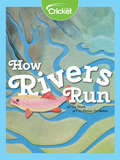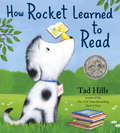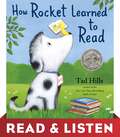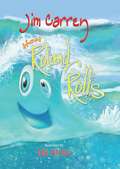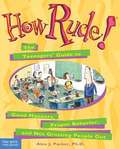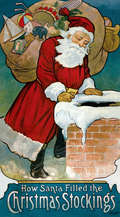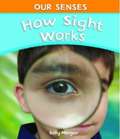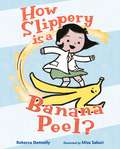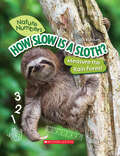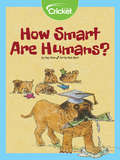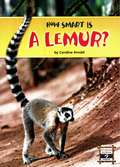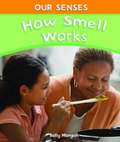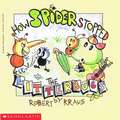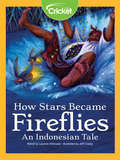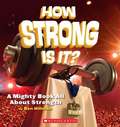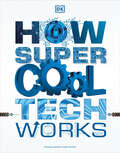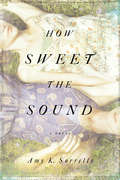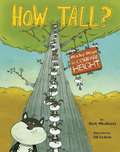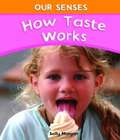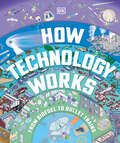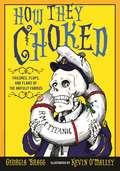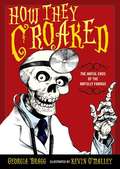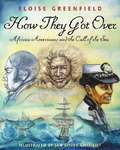- Table View
- List View
How Rivers Run
by Liz HuyckHave you ever wondered how a river forms, which animals live near rivers, or where those rivers lead? Rivers are a vital part of life and the ecosystem. Rivers help transport water to humans and animals as well. It can also be used to create energy. Water from rivers can end up in many different places downstream!
How Rocket Learned to Read (Rocket)
by Tad HillsThis sweet picture book starring an irresistible dog named Rocket and his teacher, a little yellow bird, is perfect for back-to-school! Follow along as Rocket masters the alphabet, sounds out words, and finally . . . learns to read all on his own. With a story that makes reading fun-and will even help listeners learn to read-this book is ideal for kindergarten classrooms and story hour or as a gift for that beginning reader. Fresh, charming art by Tad Hills, theNew York Timesbestselling author/illu...
How Rocket Learned to Read: Read & Listen Edition (Rocket)
by Tad HillsLearn to read with this Read & Listen edition of the New York Times bestselling picture book, starring an irresistible dog named Rocket and his teacher, a little yellow bird. Follow along as Rocket masters the alphabet, sounds out words, and finally . . . learns to read all on his own!With a story that makes reading fun—and will even help listeners learn to read—this book is ideal for kindergarten classrooms and story hour or as a gift for that beginning reader. Fresh, charming art by Tad Hills, the New York Times bestselling author-illustrator of Duck & Goose, will make this a favorite.This ebook includes Read & Listen audio narration.
How Roland Rolls
by Rob Nason Jim CarreyHOW ROLAND ROLLS, winner of a 2013 Gelett Burgess Children's Book Award, is a story about a wave named Roland who's afraid that, one day, when he hits the beach, his life will be over. But when he gets deep, he's struck by the notion that he's not just a wave - he's the whole big, wide ocean! The story shows humanity's interconnectedness through the metaphor of a wave in the ocean.The book is lavishly illustrated by Rob Nason, who won a Golden Reel award for his work as Art Director on the film Anastasia, as well as an Annie Awards nomination. His work on Thumbelina garnered the Hans Christian Andersen award. His cover for the inspiring grass-roots children's book, Saltwater Taffy, was nominated as Cover of the Year and was a finalist for the prestigious Benjamin Franklin award.
How Rude! The Teenagers' Guide to Good Manners, Proper Behavior, and Not Grossing People Out
by Alex J. PackerHere's an etiquette book that teens will want to read--because it keeps them laughing, doesn't preach, and deals with issues that matter to them, as teens themselves reported in a nationwide survey. In How Rude!, author Alex J. Packer blends outrageous humor with sound advice as he guides readers through the mysterious world of manners from A ("Applause") to Z ("Zits"). He starts by explaining why etiquette is important--because people who know how to handle themselves in social situations come out on top, get what they want, feel good about themselves, and enjoy life to the fullest. Fourteen chapters describe the basics of polite behavior in all kinds of situations at home, in school, and in the world. Teens learn how to be a host with the most (and a guest with the best), what to do (and not do) when going online or waiting in line, how to deal with rude relatives, how to act at the mall and the concert hall, how to make introductions, who invented manners, and much more. Hundreds of "Dear Alex" questions and answers cover everything from dating to breaking up, thank-you notes to table manners, ethnic jokes to social cliques, skateboarding to celebrating. Survey results reveal what teens, parents, and teachers think about manners and why they're important. Full of practical tips for every occasion, How Rude! is a serious etiquette encyclopedia--and a hilarious read.
How Santa Filled the Christmas Stockings
by W. F. Stecher Carolyn S. Hodgman<p>Christmas is coming, so Betty and Bobby are on their best behavior—but not Tommy. There's a lesson to be learned in this lighthearted story in verse about a greedy boy who tries to trick Santa Claus, only to get his comeuppance on Christmas morning. A perfect gift, this nostalgic read is sure to become a family tradition. It's a lovely facsimile of a rare 1916 edition, embellished with thirteen enchanting illustrations. Reproduced in a large format with sturdy pages, it will last for many seasons. It's also a fine collector's item for antique book lovers and fans of vintage Christmas memorabilia. <p>This is a fixed-format ebook, which preserves the design and layout of the original print book.</p>
How Santa Started
by Borys PluznykWho was Santa before we called him "Santa"? And how did he get involved with elves and reindeer anyway? What turned his beard white? And how did he begin delivering toys and gifts to children on Christmas Eve? A story from long ago holds answers to these questions that will surprise and delight you.
How Sight Works (Our Senses)
by Sally MorganThis book introduces the sense of sight and how it helps us function in everyday life.
How Slippery Is a Banana Peel?
by Rebecca DonnellyRebecca Donnelly's How Slippery Is a Banana Peel? is a picture book companion to Cats Are a Liquid celebrating the science and the slipperiness of banana peels—a perfect introduction to friction, featuring illustrations by Misa Saburi.Volcanoes roar,But banana peels race.Rockets soar,Like bananas through space.A group of kid-experimenters at a science fair explore the slipperiness of banana peels—a perfect introduction to scientific concepts! It's funny and STEM-inspired, with back matter on friction and a kitchen science experiment. These playful and mischievous banana peels will capture the imagination of readers.
How Slow Is a Sloth?: Measure the Rainforest (Nature Numbers)
by Jill EsbaumIn Nature Numbers, math is beautiful, recognizable, and all around us! Highly engaging pictures of animals and nature scenes, along with cool chalk illustrations, are used to introduce basic math concepts and encourage kids to see a world of numbers all around them.K-2 math concepts include measuring. This book explores measuring elements of the rainforest with amazing nature pictures and chalk illustrations!
How Smart Are Humans
by Kay NineHow smart can humans really be? According to a panel of expert canines, we're awfully confusing! We ignore the fact that we have a big water bowl in the bathroom, and don't even re-eat our vomit! Follow along and see why our pets might think we're a little silly.
How Smart is a Lemur (Fountas & Pinnell LLI Purple #Level S)
by Caroline Arnold<p>Brain Power: Have you ever heard of lemurs? These small creatures look like a cross between a cat and a squirrel. Scientists at Duke University are testing them to find out how smart they really are. <p>Text Elements: <p> <li>Genre: Expository <li>Text Structures: Main: Categorical; Embedded: Chronological Sequence, Description, Compare/Contrast <li>Text Features: table of contents, headings, captions, pronunciation guides, sidebars, map, glossary</li> </p>
How Smell Works (Our Senses)
by Sally MorganWhy do some things smell good and other things smell bad? This book explains where our sense of smell comes from and how it helps us function in everyday life. A lively, straightforward narrative presents scientific concepts for young readers and an activity is included enhance the learning experience.
How Spider Stopped the Litterbugs
by Robert KrausThe hero of this short story is a big, green, guitar playing spider who goes to bug school and has bug friends. His teacher is Miss Quito. A class picnic seems like a good idea until the bugs find litter dumped all over the park. They clean up the mess but before they can start having fun, a big gang of litterbugs come dumping more trash everywhere. It looks as if the little bugs will have to run back to school until Spider has a surprising idea that turns a spoiled picnic into a big party. Most of the pictures are described.
How Stars Became Fireflies An Indonesian Tale
by Jeff Crosby Laurens HillhouseHave you ever noticed how fireflies look like stars that have fallen from the sky? According to this Indonesian tale, that’s how they came to be! A greedy man overeats the stars with the help of a coconut tree and learns a lesson when he fails to properly thank the friendly tree.
How Steven the Bear Invented S'mores (Steven the Bear)
by Scott HallHow Steven the Bear Invented S’mores is a read aloud picture book with fun life lessons and colorful illustrations. Steven the Bear and his friends are excited to go on their very first camping adventure. After being sure to pack and prepare well, the Bear Bunch heads out to find the perfect campsite. They set up camp and spend their day hiking, bird watching, and finding animals. After a day full of fun, Steven and the Bear Bunch sit down to toast marshmallows. That’s when Steven has a brilliant idea…? Join Steven the Bear and his friends in this first of many adventures!
How Strong Is It?: A Mighty Book All About Strength
by Ben HillmanHOW STRONG IS IT? A Mighty Book All About Strength. How strong is a spiderweb? Spider silk is one of the most amazing materials found on the planet--natural or human-made. In fact, if each strand was as thick as a pencil, a spiderweb could stop a Boeing 747 in mid-flight!
How Super Cool Tech Works
by DKDiscover the mind-blowing high-tech inventions of the future! Incredible images reveal the secret inner workings of everything from drones and supercomputers to underwater hotels and flying cars.How Super Cool Tech Works explains how incredible technologies will shape the world of tomorrow. Explore robotics, space rockets, artificial intelligence, and even game consoles in this cutting-edge non-fiction science book for kids aged 9 and over. Also featured are state-of-the-art buildings, new ways of traveling, imaginative entertainment gadgets, and even how teleportation and invisibility cloaks might be possible in the future. Each exciting subject is explained in detail, via crisp images and engaging, child-friendly text. "How it works" panels explain each subject&’s secret inner workings.New and updated for 2020, How Super Cool Tech Works is a one-stop shop for kids who want to know what the latest and greatest technologies are, and how they will shape our world in the years to come.
How Sweet the Sound
by Amy K. SorrellsA Southern Novel of Second Chances From a distance, the Harlans appear to be the perfect Southern family. Wealth and local fame mask the drama and dysfunction swirling through their family line. But as the summer heats up, a flood tide of long hidden secrets surface. Devastation from a rape followed by the murder of two family members brings three generations of the Harlans together on their pecan plantation in Bay Spring, Alabama. Chief among them is Anniston, who by the time she turned thirteen thought she'd seen it all. But as her heart awakens to the possibility of love, she begins to deal with her loneliness and grief. This tender coming-of-age tale, inspired by the story of Tamar in 2 Samuel 13, shows how true healing and hope comes only from God. Though our earthly family can wound and disappoint, our heavenly Father brings freedom to those long held captive through His mercy and grace.
How Tall?: Wacky Ways To Compare Height (Wacky Comparisons)
by Terry Flaherty Mark Weakland Advocate-Art Staff Igor SinkovecHow many chipmunks equals the height of a redwood tree? Discover this comparison and more in this wacky, laugh-out-loud introduction to height. Quirky illustrations and lyrical text help kids explore measureable attributes of a variety of things in a uniquely engaging way. A perfect read-aloud for young science lovers and budding mathematicians.
How Taste Works (Our Senses)
by Sally MorganIntroduces the sense of taste, including how taste buds work, why the sense is important, and how the sense of taste differs in humans and animals.
How Technology Works
by DKGet inside the machinery of the modern world and understand the science that makes it all work.Have you ever been tempted to take the back off your TV? Have you wondered about what's going on beneath your feet on the street where you live? How Technology Works lifts the lid on the technology you use all the time but take for granted. It also takes you to places you'll never get the chance to see, such as the inside of a nuclear storage facility or the crew capsule on top of a moon rocket. The book takes you on a journey of discovery, starting with technology at work inside the human body before exploring cities and factories and then blasting off into space. Along the way, you'll lose yourself in super-detailed illustrations that reveal amazing hidden things and explain how they work.How Technology Works is an inspiring guide that makes technology fun, fascinating, and accessible for curious minds of all ages.
How They Choked: Failures, Flops, And Flaws Of The Awfully Famous
by Georgia BraggEveryone makes mistakes. Sometimes, epic failures even lead to super successes . . . sometimes they become deep dark secrets. But remember--to fail is human, to laugh about our shortcomings divine. From Montezuma II's mistaking a conqueror for a god to Isaac Newton turning from science to alchemy to J. Bruce Ismay's jumping the lifeboat line on theTitanic, How They Choked knocks fourteen famous achievers off their pedestals to reveal the human side of history. Successful “failures” include: Marco Polo, Queen Isabella of Spain, Montezuma II, Ferdinand Magellan, Anne Boleyn, Isaac Newton, Benedict Arnold, Susan B. Anthony, George Armstrong Custer, Thomas Alva Edison, Vincent van Gogh, J. Bruce Ismay, “Shoeless Joe” Jackson, Amelia M. Earhart
How They Croaked: The Awful Ends of the Awfully Famous
by Georgia BraggThis fascinating collection of remarkable deaths relays all the gory details of how 19 world figures gave up the ghost, including King Tut, Julius Caesar, George Washington, Edgar Allan Poe, and Henry VIII.
How They Got Over: African Americans and the Call of the Sea
by Eloise Greenfield Jan GilchristAfrican Americans have been drawn to the sea for hundreds of years. In this collection of biographies, Eloise Greenfield examines how that connection to the sea has influenced generations of African Americans -- from a shipbuilder-businessman during the American Revolution to the first woman and African American to hold the highest-ranking position in the National Oceanic and Atmospheric Administration Commissioned Corps. The lives of the extraordinary men and women included here create a stirring image of the powerful tie between African Americans and the water that has both bound them and set them free. Jan Spivey Gilchrist's artwork is as evocative as the profiles of the people it illustrates.
